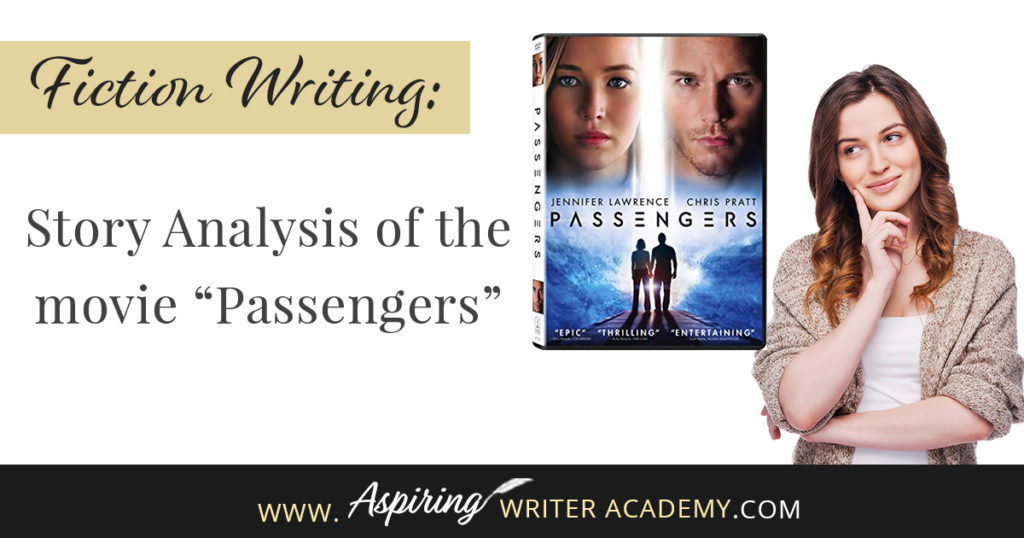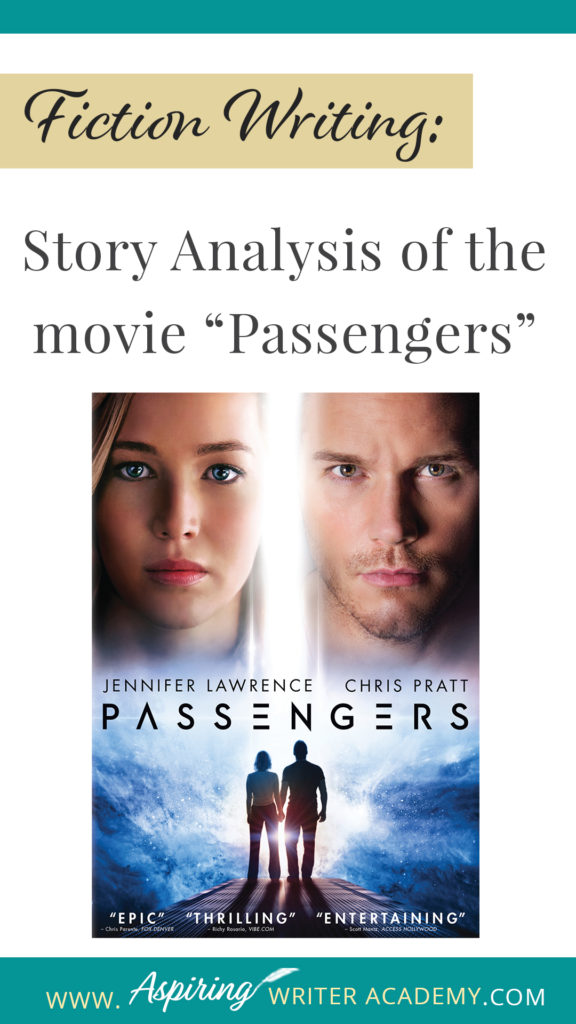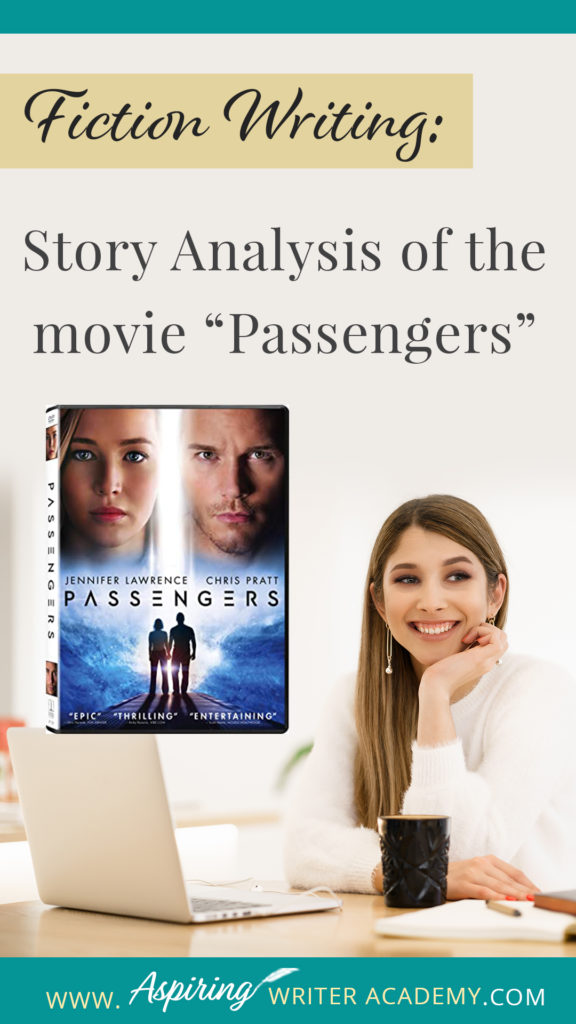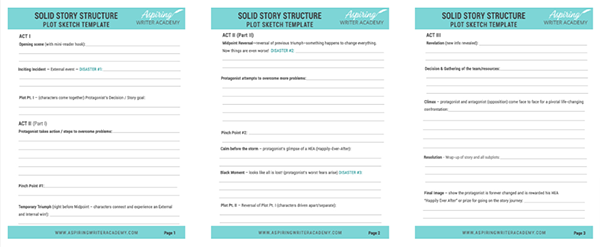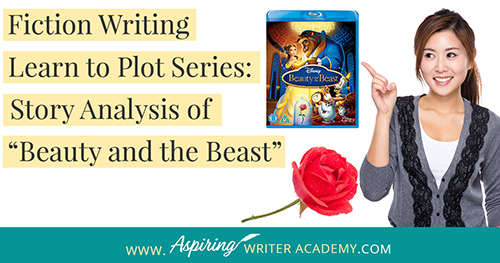Fiction Writing: Story Analysis of the movie “Passengers”

As an aspiring writer, you may have heard of plot points, pinch points, inciting incident, temporary triumph, black moment, and the climax in traditional story structure, but can you readily identify them in every movie you see or book you read?
In our post Fiction Writing: Story Analysis of the movie “Passengers” we will show you how to recognize each element and provide you with a Free Plot Template so you can draft satisfying, high-quality stories of your own.
The 2016 movie, starring Jennifer Lawrence and Chris Pratt, tells the tale of two passengers aboard an interstellar spacecraft who are awakened from their induced hibernation far too early—90 years before they are to reach their intended destination. The original screenplay was written by Jon Spaihts.
Watch Now on Amazon Prime Video: https://amzn.to/3yof6H7
One of the best ways to learn story structure is to analyze as many movies and books as you can. We suggest you watch movies because you can see the whole story played out before you in approximately two hours, which may be quicker than reading an entire book.
We also suggest that you watch the movie with our Free Downloadable Solid Story Structure Plot Template beside you so that you can write down each plot point as soon as you see it appear on the screen. Do this twenty or so more times and you will soon be on your way to becoming a story structure expert!
Click to download our free Solid Story Structure Plot Sketch Template to help you analyze books or movies, and plot stories of your very own.
Warning! This post contains story spoilers. If you have not already seen the movie and do not want any story spoilers the first time around, you might want to watch the movie for enjoyment then watch it a second time using this post to help you identify each story element.
ACT I
Opening Scenes:
What do the opening scenes of “Passengers” accomplish? How do they serve to set up the story?
- Setting.
First, you need to establish the laws of the ‘ordinary world.’ When the movie opens, we see that the setting is in the future because there is a large interstellar spacecraft heading toward another planet named Homestead II where the 5,000 passengers will start a new life. (Something our world doesn’t have the technology to do yet.)
The viewer/reader is now open to accept that there are other things the characters consider normal that we haven’t invented yet. Like the highly advanced robots, entertainment, food dispensing machines, and all sorts of other cool technical devices such as the sleep pods the characters use during space travel. Because the setting plays such a large role in this story, time is spent to set up the ‘world’ first, before introducing the characters.
- Initial Problem.
The story opens with an initial problem that the characters will have to deal with, a hook, that isn’t the main problem yet, but a situation or event to get the story rolling. In this story a meteor hits the spaceship carrying the sleep-induced passengers who are to colonize a new planet and due to a technical malfunction—one of the passengers wakes up 90 years too early!
This brings up one thematic question: Can we really place our trust in technology?
Man vs. Machines.
- Introduction of the main characters, their personalities, and the character’s relationships with one another. Also hint at relationship conflict.
When Jim awakes, he is greeted by a hologram instructor who promises him food, fun, and friends. He reacts to the mention of ‘friends’ and the viewer/reader sees that this is what he wants. This is important to him. Jim goes to his room and cleans up. He even practices how he will act in front of a mirror for when he meets the others. He is worried about his image and wants to make a good impression. He is excited to meet others.
This desire heightens his disappointment when Jim realizes he is alone. He is the only one who woke up, everyone else is still sleeping. Throughout the story the word and theme of being ‘alone’ is emphasized. Jim faces his situation by stating, “I woke up too soon.”
The viewer/reader sympathizes with this man because you can’t help but put yourself in his shoes and feel his LONELINESS. He is absolutely and utterly alone, trapped on this ship until he dies. He will never live long enough to see the new planet. Feeling alone is a unifying universal longing that many people can relate to.
Jim meets Arthur, a bartender robot who advises him to let go of what he can’t control and make the most of life right where he is. (This is another major story theme.)
However, after a year goes by, Jim is weary of life and being alone. He has already looked at the ship’s tech manuals and tried to open his own sleeping pod, but he can’t put himself back to sleep. He’s also tried to break open the door to the captain’s command center to no avail. He eats unappetizing meals in the cafeteria because his I.D. bracelet does not allow him to access better food. He found a spacesuit that allows him to take a walk outside and we see him hold the gloved hand of the suit, once again showing his desire for human interaction.
(All of these things are set up pieces that will show up again later and impact the story. Everything your character needs later should be set up in the beginning.)
Jim realizes he might be able to kill himself if he pushes the button to open the air lock chamber without his spacesuit, but he can’t do it. He runs, trips, falls, and when he gets up, he sees Aurora, a beautiful young woman asleep in a pod.
Starved for human connection, Jim visits Aurora and reads her bio, watches her videos, reads her stories. He falls in love with the journalist who hopes to write about the new world. He can’t stop thinking about her. The viewer/reader gets to know both characters, their strengths, their weaknesses.
Jim’s strength is that he is a mechanical engineer who can fix things. (This strength is also critical to the resolution of the story.) His weakness is that he will never be able to interact with another human being ever again, certainly not the girl he’s fallen in love with.
Unless…he wakes her up.
Of course, this causes a Great Moral Dilemma because his conscience will trouble him greatly if he wakes this woman up for his own benefit. For if he does this, he will also doom her to death on this ship and she too, will never see the new world.
He is the opposition to her goal. Her goal is to write about the new world, and he would be the one trying to stop her. Protagonist vs. Antagonist. This sets up their relationship/romance conflict and the audience can truly sympathize with each character and understand why their opposing goals might cause a problem between them.
Rising tension: The stakes are raised even higher (along with the story tension) when the lonely man considers waking the sleeping woman. (Risking her intended future life.)
One might also say that the over-arching antagonist is nature, with the meteor hitting the ship and the (protagonist) people on board trying to find a way to survive and fight back against the consequences the meteor produced. We will refer to that as the external layer of the story.
However, at its core, the central story is the relationship between the hero and heroine and how they work out their differences to find romance. This is the main focus, the internal story layer that engages our thoughts and emotions.
Inciting Incident:
After the opening scenes have introduced the characters and set up the genre, time period, location, hinted theme, and general pacing of the story, the protagonist is hit with the inciting incident, which rocks his or her ‘ordinary world’ and turns their life upside down.
The protagonist must now decide how to deal with this serious problem, which becomes her new focus for the remainder of the story. The action plan to overcome this serious problem becomes the protagonist’s story-worthy goal.
(The inciting incident is also referred to as the first major turning point to turn the story in a different direction or Disaster #1. What happens at the inciting incident is a game-changer.)
In “Passengers,” Jim wrestles with his desire to awaken Aurora and tries to talk himself out of it. He discusses the pros and cons with his new friend, Arthur, an android bartender. Finally, Jim gives in to his weakness—the need for companionship—and he gets the tools to open Aurora’s sleeping pod.
The moment he pushes the button to open her pod and awaken our heroine, Aurora, from sleep is the Inciting Incident. He changes their lives forever. There is no going back.
- Special Note:
Some people who are less familiar with the elements of story structure may mistakenly think the meteor hitting the spaceship is the inciting incident. However, the hero spends an entire year after that event on his own. The true inciting incident, the action that sets the present story (Jim’s relationship with this woman) in motion is when he wakes her from her sleeping pod. A “ticking clock” is also set in motion for now the days of her life are limited. The meteor hitting the ship is mere backstory at this point, explaining how these two came to be in this situation in the first place.
If you are not familiar with the elements of Solid Story Structure for Popular Fiction, you may want to see our post, How to Plot Your Fictional Novel, to help you further understand the specifics of what should be included in each section.
Plot Point I:
The inciting incident causes the story to change direction. Because the hero awakened the heroine, he is no longer alone. Plot Point I is the agreement between characters to work together to overcome the obstacles they face. In this story, the hero and heroine come together to figure out how to adjust to life aboard this spaceship. Plot Pt. I is always when the main characters come together and decide to accomplish a new story-worthy goal triggered by or in response to the inciting incident. This decision ends Act I.
ACT II (Part I)
Now we journey into the main body of the story where the characters are learning to navigate their new ‘world/situation.’ At first Aurora struggles to accept her fate, and just like Jim did when he was first awakened, she tries to break into the captain’s command center to no avail.
In the first half of ACT II the heroine helps Jim by letting him use her upgraded bracelet to gain access to ship privileges he didn’t have. Jim shows the heroine the digital dance room, the basketball court, the pool, the observatory. He also introduces her to Arthur, the android bartender, who can talk to them much like a real human. After flirting and spending time together, it looks like Jim and Aurora have both accepted their fate and settled into a happy routine.
The characters are learning, growing, being tested in their skills and in their relationship with one another. They are acquiring the know-how to face and deal with what is to come during the later segments of the story.
Pinch Point #1:
This moment usually occurs about midway through the first half of Act II. Jim instructs Arthur, the android bartender, not to tell Aurora that he was the one who awakened her from her sleeping pod. (Again—the theme of trusting in technology comes up. The viewer just knows this is foreshadowing a backfire where the heroine finds out the truth!)
The whole first half of the book, our hero keeps this big dark secret from the heroine and lets her believe she woke up by accident, just like him. The story question is set up for the viewer/reader: How will she react when she finds out the truth? The audience will keep watching or reading to find out! We fear the truth will eventually come out to ruin everything between Jim and Aurora.
The first pinch point serves to remind the hero all he could lose if he doesn’t attain his goal (of keeping the secret and convincing the heroine to fall in love with him.) Pinch Point #1 also motivates him to continue forward with renewed resolve.
Temporary Triumph:
In most stories the characters experience an unexpected win in the external plot thread that triggers a celebratory win or triumph between the characters in the internal plot thread. In a romance, this is where the characters may share some backstory and kiss.
In the movie, “Passengers”, Jim asks Aurora for a date, and they end up in the bedroom. It looks like the characters may have achieved their goals and will get their happily-ever-after. Aurora states that it is the first time in her life where she doesn’t feel alone. (Another play on that thematic word.) They celebrate Aurora’s birthday and Jim is going to propose.
ACT II (Part 2)
Midpoint Reversal
Bam! Just when everything seems fine and the goal within reach, an event happens at Midpoint, the second major plot point, to turn the story in a different direction again. Disaster #2 changes everything and reverses the short-lived temporary triumph. In a relationship story, it changes the relationship.
In “Passengers” the midpoint reversal occurs when Arthur is mistakenly told there are no secrets between Jim and Aurora. The android takes this to mean Aurora knows the truth and talks about how conflicted Jim was when he first considered opening her sleeping pod. In other words, Arthur spilled the beans! (Can’t trust technology!)
Aurora confronts Jim and is horrified to learn he woke her on purpose, dooming her to die on this ship! Their relationship is now changed. She is angry at the hero and does not want anything to do with him. It doesn’t look like anything could ever repair this damage to their relationship, except something else has happened. And this is where the external plot comes back in to push the internal plot forward again.
The ship captain wakes up. (One of the command center deck’s chief officers.) His sleeping pod has also malfunctioned. Other technological devices have also been malfunctioning and now the three of them need to figure out why.
During the second half of ACT II, the characters must struggle to overcome a new set of problems, but now they are a little more enlightened into what is actually going on with the ship and they take action in a more proactive way.
While many of the lessons learned in the first half of Act I may have been more exploratory or reactive, the second half is stepping out to use and test those lessons proactively.
In “Passengers,” the captain uses his special access I.D. bracelet to finally let Jim and Aurora into the command center where they learn there are multiple malfunctions occurring within the ship, which started when the asteroid hit and caused Jim’s sleeping pod to open.
Aurora goes swimming and when gravity shuts off, she almost drowns in a bubble of water. The captain has also told Aurora in reference to Jim, that a drowning man will pull down others with him. It’s not right, but he does it anyway because he’s drowning. When they realize the spacecraft has problems that may threaten all their lives, Aurora states they are now ‘stranded on a sinking ship.’ Always connect imagery and theme into the storyline as much as you can.
In the second half the characters are still gaining the tools and skills they will need to go into the Climax. When the captain falls ill, they take him to the health pod and the captain reveals the code to operate the machine and uses his special access I.D. bracelet to obtain the results. Jim and Aurora see how this health pod works. The captain’s sleeping pod malfunction caused 612 disorders within his body, and he does not have long to live.
Jim and Aurora realize they are going to be alone again, and they need to work together to fix the ship. The captain gives them the “tools” they will need – his special access I.D. bracelet before he dies. (See how many times this I.D. bracelet comes into play in this story!)
Pinch Point #2:
About halfway through the second half of Act II, we have Pinch Point #2. Another moment to pull on the heartstrings. While Pinch Point #1 may have led the main character to see all they had to lose if they did not press forward with their goal, Pinch Point #2 leads them to see all they might gain.
Aurora sees an old video from a friend she left behind on earth who says Aurora was never happy on earth. The friend hopes Aurora finds love, takes chances. This tugs on Aurora’s heart because she did find love with Jim, before she got mad at him, and reminds her of what’s really important.
The Calm Before the Storm:
To fix the damaged spacecraft, Aurora and Jim must put aside their differences and work together. He needs her help to do this—he cannot do it alone. And in a reversal moment, Aurora considers waking up some of the crew to help them. (Something she had been against doing before!) This turn-around is so important to their relationship!
Aurora almost gets sucked out of the air lock compartment, but Jim saves her. Together they find several holes in the ship from meteors and the ship’s damaged fusion reactor power plant, which is on fire, revealing the cause of the ship’s malfunction.
Although the tension still runs high with the external events, this is a calming moment where we see Jim and Aurora working together again, reverting back to their earlier close relationship but with an understanding they never had before. The events of the external plot have served to change their perspective and the internal plot relationship.
The Black Moment:
Jim manages to replace the computer module needed to correct the ship’s failed systems, but they can’t put out the fire threatening to explode the main reactor. They need to vent the room but the outer door to the reactor is jammed, and Jim must go outside of the ship to open it. The mission is dangerous, and Jim could die. But if they don’t fix the ship, all the passengers will die.
Jim gives Aurora the captain’s special access I.D. bracelet in case he doesn’t make it back. She realizes she loves him and can’t live on the ship without him. She pleads, “Come back to me.” This is another reversal from her earlier views, but she’s come to understand what it might be like to truly be alone.
The black moment is the dark night of the soul, the bleakest moment, which is also the third major turning point, Disaster #3.
Plot Point II:
Plot Point II follows quickly on the heels of the Black Moment. The opposite of Plot Point I, this is when the characters separate or are driven apart due to the events of the Black Moment. The protagonist finds herself alone.
Aurora and Jim separate. She will have to push the button from the inside of the ship while Jim tries to hold the door to the reactor open from the outside.
ACT III
Revelation:
Then, suddenly the protagonist gets a new piece of information that changes the situation, and the characters can see how they might succeed in their battle against the external antagonist which they must face.
Jim opens the reactor door from the outside but informs Aurora that it won’t stay open on its own. And they are out of time. Just as they feared, he must sacrifice himself. He must stay and hold open the door for the vented blast to come through when Aurora pushes the button.
Aurora realizes if she pushes the button to fix the ship, Jim will die. Her action will kill him. However, she must do it to save the other 5,000 people aboard the ship. As she struggles with this decision, we are reminded of how hard it was for Jim, when he struggled with his decision to push the button to open her sleeping pod, dooming her to die.
Decision:
Aurora decides to push the button to save the other passengers.
Re-gathering of the Team or Resources:
The action proves successful, and the ship will be okay, which wraps up the external climax and storyline. But the main storyline featuring the relationship continues.
Jim did not die, however, his tether snapped, and he is floating out into space. He will die if something isn’t done. Aurora must go out in the spacesuit (introduced earlier in the story when Jim took her on their date so it is believable that she can do this) and go save Jim.
Climax:
This is the most exciting scene in the entire book or movie. This is a face-to-face confrontation between the protagonist and the opposition. Either the protagonist succeeds once and for all or he fails. Everything is put on the line.
Aurora puts on the space suit and goes as far as her own tether will reach but it’s not long enough to reach Jim. But she does manage to grab a hold of his tether and reel him in. She drags him onto the ship and into the health pod machine, but he is declared dead. Using the captain’s special access I.D. bracelet, she is able to override the system to try to revive him if she can remember the code the captain recited. It is a struggle, but she recalls the numbers and frantically punches it in. The health pod advises that multiple procedures are not recommended. But this is Aurora’s only chance to save Jim and she commands the machine to do it anyway.
Each action is intense at the climax!
Remember also, this has to be a face-to-face confrontation between our protagonist and antagonist, which in this internal love story is Aurora and Jim.
Thanks to Aurora’s quick action, Jim is revived and he ‘awakes.’ Relieved that the ordeal is over, and they’ve succeeded, Jim and Aurora kiss.
The conflicts in both the external plot layer and the internal relationship plot layers have been faced and defeated. They have ‘won!’
Resolution:
This is where the main storyline and all sub-plots are wrapped up with their reaction to what transpired at the Climax.
With special access to things on the ship they didn’t have before, thanks to the captain’s bracelet, Jim finds that the health pod machine can function as a hibernation sleeping pod for one person. He tells Aurora that he can put her back to sleep so she can continue to Homeland with the other passengers and go forward with the life she had always wanted. (Her original goal.) Jim is willing to sacrifice his own happiness to make things right because he loves her.
Aurora says, “But you would be alone.”
Jim responds, “I’ve been alone before.” He tells her he would come and visit her.
However, the story journey has changed both characters. They can do things that they couldn’t do in the beginning.
Jim has the strength to give up his desire for companionship and live alone, without dooming Aurora’s life.
But Aurora realizes her life would be empty without Jim and gives up her original goal in favor of a new better one. She decides to stay and live out the rest of her days on the ship with Jim.
It is important to show the change in the characters at the end of the story with an action or tangible object that represents the character’s goal. In the next scene we see Jim, Aurora, and Arthur, the android bartender, celebrating when Jim finally gives Aurora the marriage proposal ring he’d wanted to give her earlier.
In a romance, there should always be a commitment at the end, along with warm fuzzy thoughts that the main couple will live happily-ever-after.
Final Image:
This is the very last image or scene of the entire story, a ‘capping off’ scene.
In “Passengers” we see the other passengers on the ship wake up at their scheduled time and when they walk into the main concourse of the spacecraft, they see the house Jim had wanted to build for Aurora and all the beautiful gardens, trees, and vegetation that they had grown to make their ‘home’ together. Evidence of a life well lived. Aurora put her journalistic talents to use and a recording describes her life with Jim, fulfilling her goal to have others read her stories.
The main theme, voiced by Arthur, who was giving Jim wise counsel earlier in the story, is on full display in this imagery. The viewer/reader sees that Jim and Aurora did indeed accept what they could not change and made the very most of the life they had together.
Which is also the message for the viewer/reader as well.
Additional Thoughts:
How does this story structure line up with your own writing? Have you included all the steps or are you missing some?
I hope that you have enjoyed our Learn to Plot Fiction Writing Series: Story Analysis of the movie “Passengers” and have downloaded the Free Solid Story Structure Plot Template to analyze more books and movies, or perhaps to outline a story of your own.
Blog Post You Might Like
If you like more help developing your story, you may wish to download our Free Brainstorming Your Story Idea Worksheet
Do you find it difficult to create compelling antagonists and villains for your stories? Do your villains feel cartoonish and unbelievable? Do they lack motivation or a specific game plan? Discover the secrets to crafting villains that will stick with your readers long after they finish your story, with our How to Create Antagonists & Villains Workbook.
This 32-page instructional workbook is packed with valuable fill-in-the-blank templates and practical advice to help you create memorable and effective antagonists and villains. Whether you're a seasoned writer or just starting out, this workbook will take your writing to the next level.
If you have any questions or would like to leave a comment below, we would love to hear from you!
Our Goal for Aspiring Writer Academy is to help people learn how to write quality fiction, teach them to publish and promote their work, and to give them the necessary tools to pursue a writing career.

ENTER YOUR EMAIL BELOW
TO GET YOUR FREE
"Brainstorming Your Story Idea Worksheet"
7 easy fill-in-the-blank pages,
+ 2 bonus pages filled with additional story examples.
A valuable tool to develop story plots again and again.
Other Blog Posts You May Like
3 Ways to Avoid Writing ‘Episodic’ Scenes in Fiction
Author Chats: Kate Breslin & Book Launch Promotion
Fiction Writing: Office Supplies to Help You Prepare to Write Your Next Novel
How to Write Act I: Opening Scenes for Your Fictional Story
Brainstorming Fiction: What to Do When Your Story Gets “Stuck”
Learn to Plot Fiction Writing Series: Story Analysis of “Beauty and the Beast”
How to Plot Your Fictional Novel (with Free Template Included)
How to Research a Setting for Your Fictional Novel
5 Questions to Create Believable Villains
Why Your Characters Need Story-Worthy Goals
3 Levels of Goal Setting for Fiction Writers
Fiction Writing: How to Write a Back Cover Blurb that Sells
How to Captivate Your Readers with Scene-Ending Hooks
Fiction Writing: How to Name Your Cast of Characters
Scene & Sequel: The Secret to Plotting an Epic Novel
Scene & Sequel: The Secret to Plotting an Epic Novel (Part 2)

is a multi-published author, speaker, and writing coach. She writes sweet contemporary, inspirational, and historical romance and loves teaching aspiring writers how to write quality fiction. Read her inspiring story of how she published her first book and launched a successful writing career.


